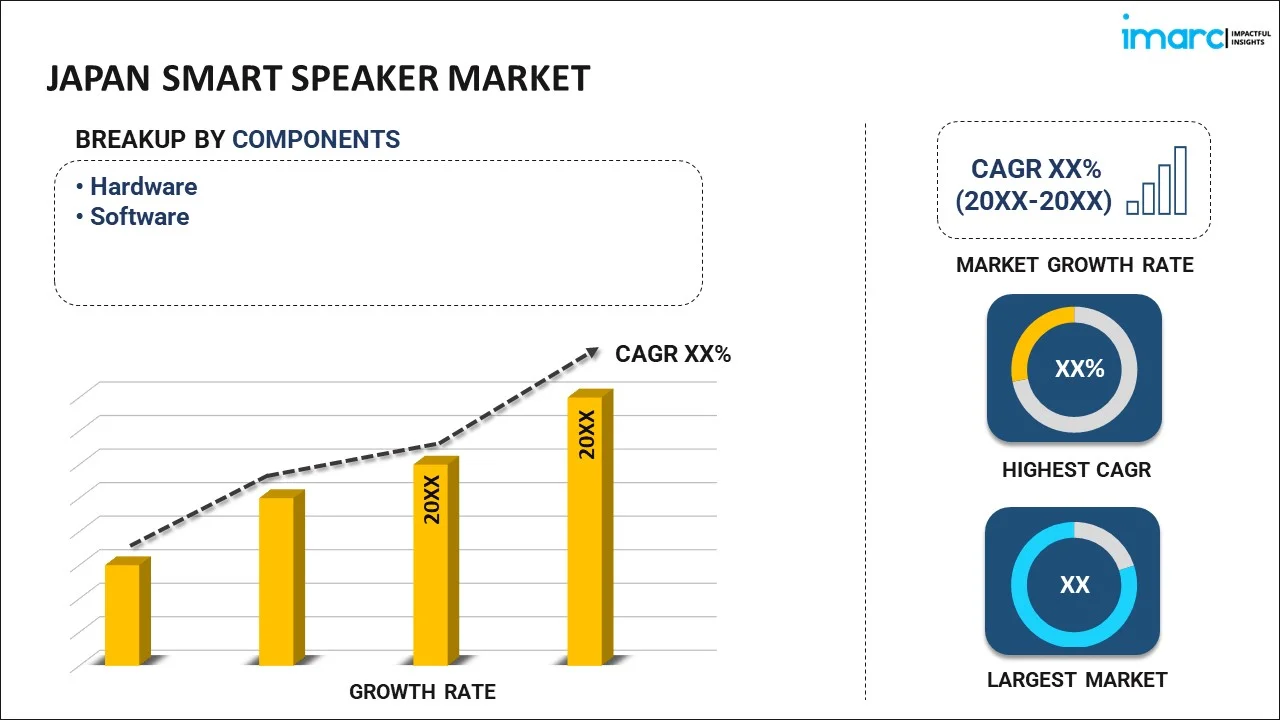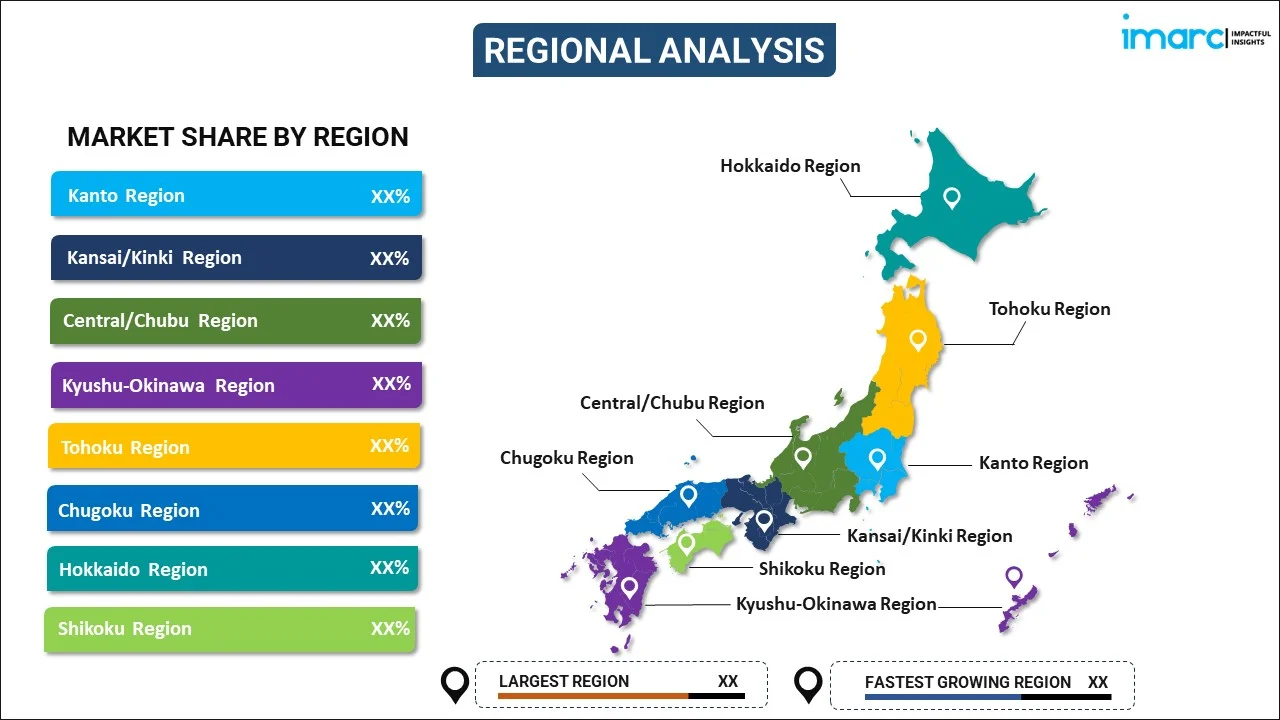
Japan Smart Speaker Market Report by Component (Hardware, Software), Intelligent Virtual Assistant (Amazon Alexa, Google Assistant, Siri, Cortana, and Others), Connectivity (Wi-Fi, Bluetooth), Price Range (Low-Range (Less than $100), Mid-Range ($101 to $200), Premium (Above $200)), Distribution Channel (Online, Offline), End User (Personal, Commercial), and Region 2025-2033
Market Overview:
The Japan smart speaker market size reached USD 597.9 Million in 2024. Looking forward, IMARC Group expects the market to reach USD 860.5 Million by 2033, exhibiting a growth rate (CAGR) of 4.13% during 2025-2033. The increasing adoption of smart home technologies, advancements in AI and natural language processing, and an expanding tech-savvy consumer base eager to embrace innovative, connected devices that enhance convenience and home automation represent some of the key factors driving the market.
|
Report Attribute
|
Key Statistics
|
|---|---|
|
Base Year
|
2024 |
|
Forecast Years
|
2025-2033
|
|
Historical Years
|
2019-2024
|
| Market Size in 2024 | USD 597.9 Million |
| Market Forecast in 2033 | USD 860.5 Million |
| Market Growth Rate (2025-2033) | 4.13% |
A smart speaker is an advanced technological device that integrates the functionalities of a traditional speaker with enhanced features like voice command, internet connectivity, and artificial intelligence. These speakers are currently revolutionizing how users interact with technology and serve as a central hub for various smart home devices, facilitating seamless control and automation. Equipped with virtual assistants, they respond to voice commands, performing tasks like playing music, providing weather updates, setting alarms, and answering queries. Smart speakers are increasingly becoming a staple in modern homes, offering a hands-free, efficient way to manage daily tasks. They are powered by artificial intelligence (AI) algorithms that learn from user interactions, thus personalizing experiences and improving responsiveness over time. These devices connect to other smart appliances, enabling users to control lights, thermostats, and even security systems through simple voice commands. The market for smart speakers in Japan is rapidly expanding due to advancements in AI and growing consumer demand for convenient, connected living solutions. As this technology evolves, it is expected to play a more integral role in the Internet of Things (IoT) ecosystem, offering more advanced features and integration capabilities.
Japan Smart Speaker Market Trends:
The Japan smart speaker market is currently experiencing significant growth, fueled by a convergence of factors that reflect both technological advancements and shifting consumer preferences. One of the primary drivers is the increasing adoption of smart home devices. As Japanese households become more connected, the demand for devices that can serve as central control units, like smart speakers, is rising. Besides playing music or providing news updates, these devices are integral in managing home automation systems and controlling lighting, heating, and security systems, which resonates with the expanding tech-savvy population in Japan. Moreover, the advancement in artificial intelligence (AI) and natural language processing (NLP) technologies represents another major growth-inducing factor. These improvements have enhanced the functionality and user experience of smart speakers, making them more appealing to a broader audience. The ability of these devices to understand and respond in Japanese, considering the language's unique nuances, has further accelerated the product adoption rate. Additionally, the aging population in the country presents a unique opportunity for smart speakers as these devices can assist older adults by making it easier to control home appliances, set reminders for medication, and even provide emergency assistance, thus promoting independent living. In line with this, the heightened influence of major tech companies like Amazon, Google, and Sony is contributing to the market growth. These companies are investing in developing more advanced and user-friendly devices and creating partnerships and ecosystems that integrate numerous services and applications, enhancing the overall utility of smart speakers. Furthermore, with more people spending time at home amid the recent coronavirus (COVID-19) pandemic, there has been a growing consumer interest in smart home technologies that offer convenience and entertainment. Along with this, changing consumer behavior in Japan, which leans toward the early adoption of technology, plays a critical role in driving market growth. The tech-conscious consumer base in Japan is always eager to embrace innovative products, particularly those that offer convenience and connectivity, further propelling market growth.
Japan Smart Speaker Market Segmentation:
IMARC Group provides an analysis of the key trends in each segment of the market, along with forecasts at the country level for 2025-2033. Our report has categorized the market based on component, intelligent virtual assistant, connectivity, price range, distribution channel, and end user.
Component Insights:

- Hardware
- Software
The report has provided a detailed breakup and analysis of the market based on the component. This includes hardware and software.
Intelligent Virtual Assistant Insights:
- Amazon Alexa
- Google Assistant
- Siri
- Cortana
- Others
A detailed breakup and analysis of the market based on the intelligent virtual assistant have also been provided in the report. This includes amazon alexa, google assistant, siri, cortana, and others.
Connectivity Insights:
- Wi-Fi
- Bluetooth
The report has provided a detailed breakup and analysis of the market based on the connectivity. This includes wi-fi and bluetooth.
Price Range Insights:
- Low-Range (Less than $100)
- Mid-Range ($101 to $200)
- Premium (Above $200)
A detailed breakup and analysis of the market based on the price range have also been provided in the report. This includes low-range (less than $100), mid-range ($101 to $200), and premium (above $200).
Distribution Channel Insights:
- Online
- Offline
The report has provided a detailed breakup and analysis of the market based on the distribution channel. This includes online and offline.
End User Insights:
- Personal
- Commercial
A detailed breakup and analysis of the market based on the end user have also been provided in the report. This includes personal and commercial.
Regional Insights:

- Kanto Region
- Kansai/Kinki Region
- Central/ Chubu Region
- Kyushu-Okinawa Region
- Tohoku Region
- Chugoku Region
- Hokkaido Region
- Shikoku Region
The report has also provided a comprehensive analysis of all the major regional markets, which include Kanto Region, Kansai/Kinki Region, Central/ Chubu Region, Kyushu-Okinawa Region, Tohoku Region, Chugoku Region, Hokkaido Region, and Shikoku Region.
Competitive Landscape:
The market research report has also provided a comprehensive analysis of the competitive landscape. Competitive analysis such as market structure, key player positioning, top winning strategies, competitive dashboard, and company evaluation quadrant has been covered in the report. Also, detailed profiles of all major companies have been provided.
Japan Smart Speaker Market Report Coverage:
| Report Features | Details |
|---|---|
| Base Year of the Analysis | 2024 |
| Historical Period | 2019-2024 |
| Forecast Period | 2025-2033 |
| Units | Million USD |
| Scope of the Report | Exploration of Historical Trends and Market Outlook, Industry Catalysts and Challenges, Segment-Wise Historical and Future Market Assessment:
|
| Components Covered | Hardware, Software |
| Intelligent Virtual Assistants Covered | Amazon Alexa, Google Assistant, Siri, Cortana, Others |
| Connectivities Covered | Wi-Fi, Bluetooth |
| Price Ranges Covered | Low-Range (Less than $100), Mid-Range ($101 to $200), Premium (Above $200) |
| Distribution Channels Covered | Online, Offline |
| End Users Covered | Personal, Commercial |
| Regions Covered | Kanto Region, Kansai/Kinki Region, Central/ Chubu Region, Kyushu-Okinawa Region, Tohoku Region, Chugoku Region, Hokkaido Region, Shikoku Region |
| Customization Scope | 10% Free Customization |
| Post-Sale Analyst Support | 10-12 Weeks |
| Delivery Format | PDF and Excel through Email (We can also provide the editable version of the report in PPT/Word format on special request) |
Key Questions Answered in This Report:
- How has the Japan smart speaker market performed so far and how will it perform in the coming years?
- What has been the impact of COVID-19 on the Japan smart speaker market?
- What is the breakup of the Japan smart speaker market on the basis of component?
- What is the breakup of the Japan smart speaker market on the basis of intelligent virtual assistant?
- What is the breakup of the Japan smart speaker market on the basis of connectivity?
- What is the breakup of the Japan smart speaker market on the basis of price range?
- What is the breakup of the Japan smart speaker market on the basis of distribution channel?
- What is the breakup of the Japan smart speaker market on the basis of end user?
- What are the various stages in the value chain of the Japan smart speaker market?
- What are the key driving factors and challenges in the Japan smart speaker?
- What is the structure of the Japan smart speaker market and who are the key players?
- What is the degree of competition in the Japan smart speaker market?
Key Benefits for Stakeholders:
- IMARC’s industry report offers a comprehensive quantitative analysis of various market segments, historical and current market trends, market forecasts, and dynamics of the Japan smart speaker market from 2019-2033.
- The research report provides the latest information on the market drivers, challenges, and opportunities in the Japan smart speaker market.
- Porter's five forces analysis assist stakeholders in assessing the impact of new entrants, competitive rivalry, supplier power, buyer power, and the threat of substitution. It helps stakeholders to analyze the level of competition within the Japan smart speaker industry and its attractiveness.
- Competitive landscape allows stakeholders to understand their competitive environment and provides an insight into the current positions of key players in the market.
Need more help?
- Speak to our experienced analysts for insights on the current market scenarios.
- Include additional segments and countries to customize the report as per your requirement.
- Gain an unparalleled competitive advantage in your domain by understanding how to utilize the report and positively impacting your operations and revenue.
- For further assistance, please connect with our analysts.
 Request Customization
Request Customization
 Speak to an Analyst
Speak to an Analyst
 Request Brochure
Request Brochure
 Inquire Before Buying
Inquire Before Buying




.webp)




.webp)












